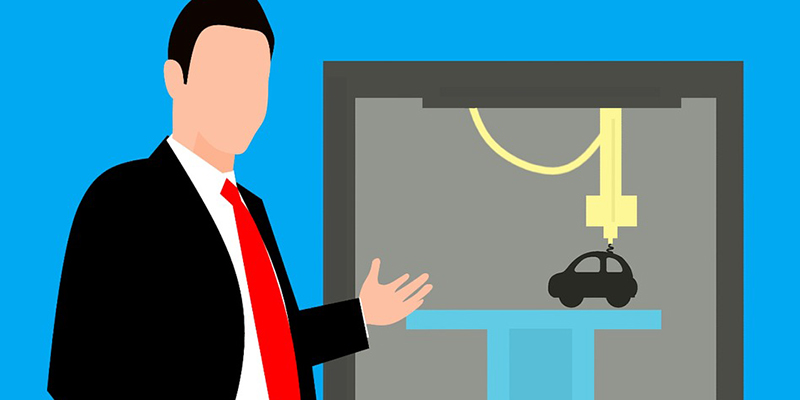3D printing: A game changer for the automotive manufacturing industry?
3D printing or additive manufacturing is one technology which has revolutionised the automotive industry. Significant advances in the field over the past decade has transformed the design, development, manufacturing and distribution processes in the sector.
This has made way for novel designs, lighter and safer products, shorter lead times, and lower costs. Hence, 3D printing has become the darling of the automotive world, enhancing the functionality and value of existing products in every way.
The concept seems new but has been around for more than 30 years. It involves a process where a 3D design data described in a digital file is used to develop a component by depositing materials in layers. The materials used in 3D printing include a wide range of metals, plastics, and composite materials.
The market for automotive 3D printing has been experiencing a phenomenal growth over the years since the advent of the technology. A report by Allied Market Research states that the automotive 3D printing industry is likely to reach $2,730m by 2023, growing at a CAGR of 19.7% from 2017 to 2023.
The need for efficient management of logistics, as well as reduced manufacturing time and associated costs, are driving the demand for the industry. Therefore, 3D printing exhibits wide applications within the sector for prototyping and tooling, research and development, and product innovation. On the other hand, the market faces certain challenges such as expensiveness of 3D printing software and the dearth of skilled labour.
The additive manufacturing field is highly competitive and therefore, large and small players in the space focus on specific capabilities that can lead to greater competitiveness. Some of these capabilities include fewer design restrictions and directly produce final components by eliminating the need for new tooling.
Currently, several developments are taking place in the industry. Local Motors, a vehicle manufacturing company based in Arizona recently installed the world’s largest composite 3D printer called the Thermwood LSAM at Knoxville micro-factory which will be used to produce the company’s autonomous Olli shuttle.
Audi, a German automobile manufacturer adopted Stratasys 3D printing methods with the aim of drastically reducing the time needed for prototyping and accelerating the design verification process. Wipro3D, the additive manufacturing unit of Wipro Infrastructure Engineering recently introduced a solution and experience centre for metal 3D printing in Bengaluru, India.
AMFG, a leader of automation software for industrial 3D printing unveiled a new software platform that makes use of artificial intelligence to automate additive manufacturing production. Coherent, a leading provider of laser and laser-based solutions acquired O.R. Lasertechnologie, a company that manufactures high precision tools for laser additive manufacturing with the aim of increasing the former company’s product portfolio in additive manufacturing.
 Local motors installs large composite 3D printer
Local motors installs large composite 3D printer
Local Motors recently completed the installation of a composite 3D printer called the Thermwood LSAM at its Knoxville, TN micro factory. Considered the largest in the world and spanning ten by 40 feet, the machine will be used to print components for the company’s innovative Olli vehicle, an autonomous 3D printed shuttle bus. The Thermwood LSAM system was developed with the intention of manufacturing large-scale structures and parts using composite materials and an additive approach.
Audi adopts Stratasys 3D printing
In June 2018, Audi announced that its Pre-Series Centre and Plastics 3D Printing Centre in Ingolstadt, Germany adopted Stratasys 3D printing methods. Stratasys’ J750 full colour, multi-material 3D printer is used to produce full colour physical models of automotive parts, reduce the time needed for prototyping, and accelerate the design verification process.
The design verification process is crucial in automotive manufacturing as it determines the approval or denial of new design concepts before a new vehicle is developed. According to Audi, it has achieved prototyping lead time reductions by up to 50% for certain parts with full colour, multi-material printing capabilities. One of the components that has benefited from the printer is tail light covers of the vehicle. The covers were typically prototyped using milling or moulding and had to be made in multiple parts.
Wipro3D launches centre for metal 3D printing
In March 2018, Wipro3D introduced a solution and experience centre for metal 3D printing in Bengaluru. The centre, which measures 12,000 square feet, was inaugurated by Wipro Chairman, Azim Premji.
Equipped with leading-edge build technology, post-processing, research, characterisation and validation facilities, the centre is the country’s foremost fully integrated Metal Additive Manufacturing facility, recommended with AS9100 Rev D certification.
AMFG launches AI software platform for industrial 3D printing
In June 2018, a novel software platform that employs artificial intelligence to automate additive manufacturing production was launched by AMFG. The AI capabilities of the company provide manufacturers with complete production automation for end use parts, including scheduling automation, printability analyses, and post-processing automation.
Coherent acquires O.R. Lasertechnologie
In May 2018, Coherent acquired O.R. Lasertechnologie, a company that manufactures high precision tools for laser additive manufacturing with the aim of increasing the former company’s product portfolio in additive manufacturing. The acquisition provides Coherent with a complementary product line that increases their solutions portfolio in additive manufacturing.
Moreover, the deal allows the latter’s products to seamlessly integrate with the former’s current offering. O.R. mainly deals with direct metal deposition and selective layer melting technologies and systems cutting, welding, marking, and engraving serving industries such as automotive, dental, aerospace, and others.










